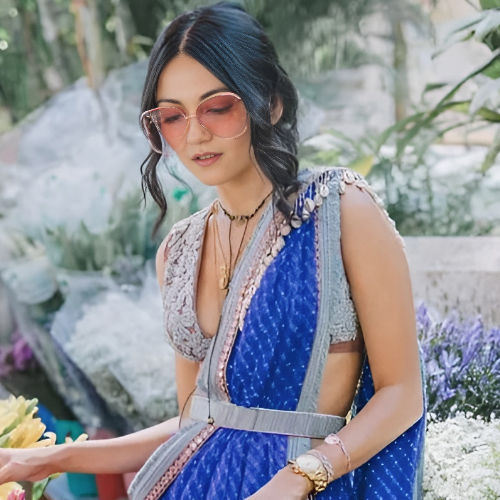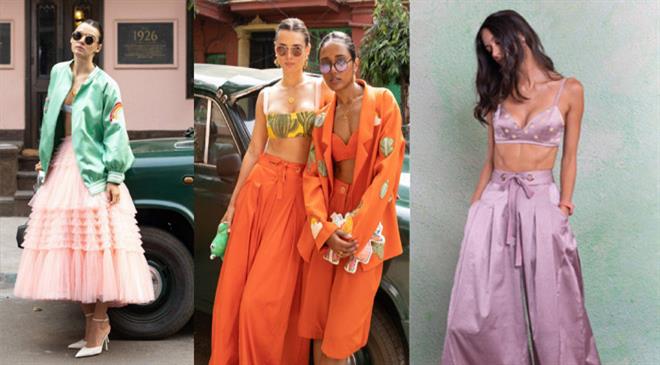
Boo
Co – founder
Brand - The Little Black Bow
We create modern embroidery with traditional techniques
India-based fashion label The Little Black Bow aims to amalgamate a contemporary design aesthetic, silhouettes, and stories with Indian sensibilities, workmanship, and crafts. In a chat with Fibre2Fashion, Co-founder Boo shares about the label’s initial struggles and how sustainability is incorporated into their brand.
Fibre2Fashion: What inspired you to become a designer, and how did you get started in the industry?
Boo:
I remember watching a runway show on TV; it was Kenzo. At first, I couldn’t understand what was happening because it seemed like the people onscreen had covered themselves in so many heavy pieces of clothing, trying to balance scarves on very high hairdos atop which sat hats. I even found it hilarious. But also unfolding before me was a story and it was being told by people walking in very strange shoes on a narrow strip. Somehow the curiously heavy clothes all seemed to fit together, and the colours were beautiful, and all the patterns were like a kaleidoscope coming to life. I was a child, and I loved my storybooks and cartoons and this seemed like an almost similar medium of getting a story except there were no words and you were free to imagine whatever you wanted. I think this was the first moment that pushed me towards design. My interest grew with my grandmother’s kota saris, my grandfather’s stories about handlooms and handweaving. I remember one day when my grandma was in the garden, my mother was singing a song wearing a benarasi sari, my grandfather was humming that same tune almost inaudibly, and there were mogra and hibiscus flowers around. The scene seemed like part of a story, a scene in time and there were patterns upon patterns that were all so different and yet fit together.
F2F: How did you come up with the name ‘The Little Black Bow’? What is the story behind it?
B:
We started with an idea that we wanted to make innerwear as outerwear. That’s why the bow. But also, there was the idea of packages, surprises, and presents wrapped in black bows. Luxury, elegance, mystery. Black also happens to be our favourite colour. And ‘the big black bow’ sounded a bit absurd. So, ‘the little black bow’ it was.
F2F: How would you describe your brand’s aesthetic, and what sets it apart from others in the industry?
B:
Our aesthetic is good design. Modern lines, the delicate feel of lingerie, the allure of sensuality amalgamating with tradition. It is the old and new really co-existing. This is all that sets our brand apart from others.
F2F: Can you walk us through your design process—from inspiration to finished product?
B:
Mostly we start with a storyboard and work on characters, time period, and history. Embroideries, prints, and fabrics are designed based on these. Samples for silhouettes and artwork for embroideries are created. Muslins are made. Printed artwork of embroidery is pasted. Alterations and adjustments are made to these. A colour board is created. Several swatches are sampled to get the exact colours we’re looking for. The question is always, what do you want the person wearing this to feel? The answers vary from strong, awkward, sexy, childlike, and even crazy. The answer usually is the finished product. There are so many details and people involved in this process. Number of stitch lines per inch, finish, artisans, art, sustainable methods, chemical free dyeing, handmade latkans, embroidered buttons, loops, labels, quilting, fusing, piping, taping… I’m sure I’ve forgotten to add many things here.
F2F: What sets your designs apart from others in the industry?
B:
We just do what we do without paying too much attention on being different. However, we ensure to never plagiarise. We focus on old crafts and sustainability. We handweave our fabrics and hand embroider everything. Our quality is not compromised. We don’t use polyester blends. We have endeavoured to keep handweaving and hand-embroidery alive as much as we can. Machine-made clothing doesn’t really have the same beauty.
F2F: What challenges have you faced in your career as a designer, and how have you overcome them?
B:
F2F: Can you share some of your favourite design projects that you’ve worked on and why they are meaningful to you?
B:
The Vintage Sari Project. We upcycle old saris that mean something to the girls who bring them to us. Usually handwoven, these are mostly a memory to hold on to one’s mother or grandmother. We turn these saris into lehengas which can be opened out into saris at any point if you so wish. It’s important to us because that’s the ethos of our label—old and new.
F2F: How do you stay on top of the latest trends in the industry while maintaining your brand’s unique voice and aesthetic?
B:
We don’t usually follow trends except for the colour forecasts. We have a signature way of creating design and that’s what we do for each collection. If by chance, we happen to fall upon a trend then we’re happy that happened for us. But we don’t let trends pollute the design process.
F2F: Indian weddings are known for their rich cultural and traditional elements. How do you incorporate these elements into your designs while still maintaining a modern aesthetic?
B:
We use traditional fabrics—like bandhej, chanderi, and benarasis. Our lines (cuts) are modern. Our silhouettes are cut to full vintage skirts, darted crops, and bralettes. If one element is traditional, then we balance it with modern fabric. We create modern embroidery with traditional techniques.
F2F: Fabrics and embroidery play a crucial role in Indian bridal wear. What is your sourcing process for fabrics and embellishments, and how do you ensure the quality of your materials?
B:
We work with weavers directly in many parts of India to source our fabrics. We work with craftsmen from different parts of the country for embroidery too. Usually for embellishments you have to build relationships over time with suppliers and after enough time passes you know whom to trust and who doesn’t compromise on quality.
F2F: What styling tips would you suggest to a Gen Z bride to enhance her bridal outfit?
B:
F2F: What advice would you give to someone who is interested in pursuing a career in fashion design?
B:
I would tell them to simply learn and get as much practical experience as they can. It’s really not at all glamourous.
F2F: How do you incorporate sustainability into your brand, and why is it important to you as a designer?
B:
F2F: Please tell us about any upcoming projects or collaborations that you’re excited about.
B:
We are super excited about our new line. It is pastel and floral—like a monotone spring. We’re using a lot of handwoven fabrics and are in the middle of the design process right now.
F2F: As a couture designer, what legacy do you hope to leave in the industry?
B:
I stand for authenticity, originality, simplicity. Keeping old arts alive is something I believe in.

Abhay Gupta
Rahul Mehta
Fanny Vermandel
Bill D’Arienzo
Gabi Seligsohn
Pradip Mehta
Aseem Prakash
Arun Sirdeshmukh
Anurag Batra
Rahul Mehta
20230103183907.png)

_8.JPG)








